Elizabeth Clarke Wolstenholme-Elmy
Elizabeth Clarke Wolstenholme-Elmy (died 12 March 1918) was a life-long campaigner and organiser, significant in the history of women's suffrage in the United Kingdom. She wrote essays and some poetry, using the pseudonyms E and Ignota.

Early life
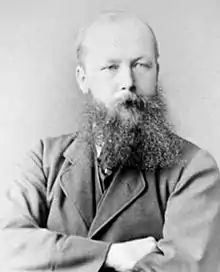
Elizabeth Wolstenholme spent most of her life in villages and towns which now form part of Greater Manchester. She was born in Cheetham Hill, the third child and only daughter of Elizabeth (née Clarke), who died shortly after her daughter's birth, and the Rev. Joseph Wolstenholme, a Methodist minister, [1] who died before she was 14. She was reportedly baptised on 15 December 1833 in Eccles.[2]
Her elder brother, also Joseph Wolstenholme (1829–1891), was afforded an education, and became a professor of mathematics at Cambridge University, but Elizabeth was not permitted to study beyond two years at Fulneck Moravian School. Despite this limited formal education, she continued learning what she could, and became headmistress of a private girls' boarding school in Boothstown near Worsley. She stayed there until May 1867, when she moved her establishment to Congleton, Cheshire.
Campaigning
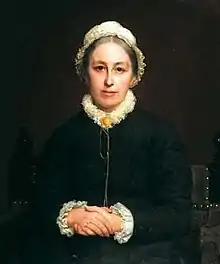
Wolstenholme, dismayed with the woeful standard of elementary education for girls, joined the College of Preceptors[3] in 1862 and through this organisation met Emily Davies. They campaigned together for girls to be given the same access to higher education as boys. Wolstenholme founded the Manchester Schoolmistresses Association in 1865[4] and in 1866 gave evidence to the Taunton Commission, charged with restructuring endowed grammar schools, making her one of the first women to give evidence at a Parliamentary select committee.
In 1867, Wolstenholme represented Manchester on the newly formed North of England Council for Promoting the Higher Education of Women. Davies and Wolstenholme quarrelled over how women should be examined at a Higher Level[5] as Wolstenholme, who had formed the Manchester branch of the Society for Promoting the Employment of Women in 1865,[6] was keen for a curriculum aimed at developing skills for employment, whereas Davies wished for women to be taught the same syllabus as men.
Wolstenholme founded the Manchester Committee for the Enfranchisement of Women in 1866 and began 50 years of vigorous campaigning for women's suffrage — the right to vote. She gave up her school in 1871 and became the first paid employee of the women's movement when she was employed to lobby Parliament with regard to laws that were injurious to women.[7] Nicknamed 'the Scourge of the Commons' or the 'Government Watchdog', Wolstenholme took her role seriously. When local women's suffragist groups faltered following the disappointment of failed suffrage bills, Wolstenholme was instrumental in maintaining the momentum of her city's committee with a re-grouping in 1867 under the name Manchester Society for Women's Suffrage.
In 1877, the women's suffrage campaign was centralised as the National Society for Women's Suffrage. Wolstenholme was a founding member (with Harriet McIlquham and Alice Cliff Scatcherd) of the Women's Franchise League in 1889.[8][9] Wolstenholme left the organisation and founded the Women's Emancipation Union in 1891.[10]
Women's Emancipation Union 1891–1899
Wolstenholme founded the Women's Emancipation Union in September 1891 following an infamous court case. Regina v Jackson, known colloquially as the Clitheroe Judgement, occurred when Edmund Jackson abducted his wife in a bid to enforce his conjugal rights, long before the concept of marital rape existed. The court of appeal freed Mrs Jackson under Habeas corpus.[11]
Elizabeth Wolstenholme recognised the significance of this judgement in relation to coverture, the principle that a wife's legal personhood was subsumed in that of her husband.[2] She funded the WEU by subscriptions and by finding a benefactor, Mrs Russell Carpenter.[12] The WEU campaigned for four great equalities between men and women: in civic rights and duties, in education and self-development, in the workplace, and in marriage and parenthood. It pioneered cross-class collaborations, encouraging women's resistance to authority while their right to vote remained unacknowledged. It also advocated making women's suffrage a test question in the selection of prospective parliamentary candidates.[13]
The WEU committee held an annual conference and over 150 public meetings between 1892 and 1896. There were ten local organisers in cities from Glasgow to Bristol, and international subscriptions of over 7,000. A short-lived Parliamentary subcommittee was established in 1893. Executive members included Mona Caird, Harriot Stanton Blatch, Caroline Holyoake Smith, and Charles W. Bream Pearce (husband of Isabella Bream Pearce). Members include Lady Florence Dixie, Charlotte Carmichael Stopes, and George Jacob Holyoake. Isabella Ford worked on behalf of the WEU at outdoor rallies in London's East End in 1895.[13]
Papers included Amy Hurlston's "The Factory work of Women in the Midlands" and William Henry Wilkins's "The Bitter Cry of the Voteless Toiler", both in 1893, and Isabella Bream Pearce's "Women and Factory Legislation" in 1896.
Following the Local Government Act 1894, the WEU worked to encourage those women who were covered by it (mostly property owners) to stand for election in bodies of local administration, or at least to vote. Over 100 of the WEU organisers were elected as Poor Law Guardians or Parish Councillors.
Following the death of their benefactor and a halving of their subscriptions in the slump following the loss of the 1897 Women's Suffrage Bill, the WEU folded. The final meeting was held in 1899, when the speakers included Harriot Stanton Blatch and Charlotte Perkins Gilman.[13]
WSPU

Wolstenholme, a friend and colleague of Emmeline Pankhurst, was invited onto the executive committee of the Women's Social and Political Union.[14] The WEU is starting to be recognised as a forerunner to the combative 'militant' WSPU suffragettes.[13]

She was on the stage when Keir Hardie and Pankhurst spoke to a large crowd in Trafalgar Square, and also wrote an eyewitness account of the 1906 Boggart Hole Clough meeting and the 1908 Women's Sunday where she was honoured with her own stand. In the 1911 Coronation Procession, watching from a balcony, she was dubbed 'England's oldest' suffragette ('militant suffragist'). Wolstenholme resigned from the WSPU in 1913 when its violent activities threatened human life.
.jpg.webp)
Further activities
She became vice-president of the Women's Tax Resistance League in the same year. She also gave her support to the Lancashire and Cheshire Textile and other Workers' Representation Committee, formed in Manchester during 1903 headed by Esther Roper.[15]
Wolstenholme was not a single issue campaigner and wanted parity between the sexes. She became secretary to the Married Women's Property Committee from 1867 until its success with the introduction of the Married Women's Property Act 1882.[16] In 1869, she invited Josephine Butler to be president of the Ladies National Association for the Repeal of the Contagious Diseases Acts, a campaign which succeeded in 1886. In 1883, Wolstenholme worked for the Guardianship of Infants Committee that became an act in 1886 (see Custody of Infants Act 1873).
Personal life
Wolstenholme met silk mill owner, secularist, republican (i.e. anti-monarchist), and women's rights supporter Benjamin John Elmy (1838–1906) when she moved to Congleton. He became her soulmate and domestic partner. Elmy was born in Hollingsworth to Benjamin, an Inland Revenue officer, and Jane (née Ellis) Elmy.[17] Working as a teacher in his early 20s, Elmy lost his faith and became a factory manager in Lancashire's textile trade. It was this work that gave him insights into economic hardships that beset women workers [18]
In 1867, Wolstenholme and Elmy set up a Ladies' Education Society that was open to men. They became active in the women's movement, joining Wolstenholme's committees. The couple began living together in the early 1870s, following the free love movement and horrifying their devout Christian colleagues. When Wolstenholme became pregnant in 1874, her colleagues were outraged and demanded that they marry, against their personal beliefs. Despite the couple going through a civil marriage registry ceremony in 1874, she was forced to give up her job in London.
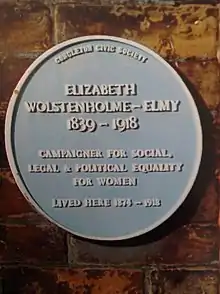
The couple moved to Buxton House, Buglawton, where Wolstenholme-Elmy gave birth to their son, Frank, in 1875. Frank Elmy was educated at home. In 1886, Benjamin J. Elmy was elected as Master of the Congleton Lodge of the Fair Trade League (supporting protection of British industry) and both Wolstenholme and Elmy were popular speakers at events organised against the free trade laws. Elmy and Co. ceased trading in 1888 and Elmy retired due to ill health in 1891.[13] In 1897, he founded the first Male Electors League for Female Suffrage (see also the 1907 Men's League for Women's Suffrage).
Deaths
The couple remained married until Elmy's death in 1906. Wolstenholme died on 12 March 1918. Her funeral was held at the Manchester Crematorium.
Works
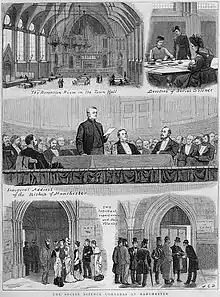
Wolstenholme wrote prolifically, including papers for the National Association for the Promotion of Social Science and articles for feminist publications such as Shafts and national newspapers such as the Westminster Review. Pamphlets concerning her campaigns were also published by organisations like the Women's Emancipation Union.[19]
Her writing includes:
- The 'Report of the Married Women's Property Committee: Presented at the Final Meeting of their Friends and Subscribers' Manchester 1882.
- 'The Infants' Act 1886: The record of three years' effort for Legislative Reform, with its results published by the Women's Printing Society 1888.
- 'The Enfranchisement of Women' published by the Women's Emancipation Union 1892.
The British Library holds her papers and those of the Guardianship of Infants Act and the Women's Emancipation Union.[19]
Wolstenholme wrote poetry as well. 'The Song of the Insurgent Women' was published on 14 November 1906 and (as Ignota) 'War Against War in South Africa' on 29 December 1899, shortly after the start of the Second Boer War.[19]
Posthumous recognition
.jpg.webp)
A blue plaque was installed at her home, Buxton House, by the Congleton Civic Society. It reads Elizabeth Wolstenholme-Elmy 1839–1918 Campaigner for social, legal and political equality for women lived here 1874–1918 (citing "1839" as Wolstenholme-Elmy's year of birth, but other sources cite 1833).
Her name and image, and those of 58 other women's suffrage supporters, are etched on the plinth of the statue of Millicent Fawcett in Parliament Square, London, which was unveiled in 2018.[20]
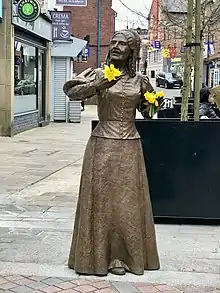
In April 2021, a new Congleton linkroad was named Wolstenholme Elmy Way in honour of Elizabeth and her husband, Benjamin.[21]
A charity[22] was set up in Congleton in 2019 to raise her profile. Elizabeth's Group raised funds to create a statue in Wolstenhome's memory.[23] It was designed by sculptor Hazel Reeves and unveiled by Baroness Hale of Richmond on International Women's Day, 8 March 2022.[24][25]
References
Notes
- Crawford (2003), p. 225
- Stanley Holton, Sandra (2004). "Elmy, Elizabeth Clarke Wolstenholme (1833–1918), campaigner for women's rights". Oxford Dictionary of National Biography (online ed.). Oxford University Press. doi:10.1093/ref:odnb/38638. ISBN 9780198614128. Retrieved 26 February 2015. (Subscription or UK public library membership required.)(subscription required)
- Wright (2011), p. 43
- Wright (2011), p. 60
- Wright (2011), p. 65
- Wright (2011), p. 55
- Wright (2011), pp. 62, 71
- Wright (2011), p. 137
- Holton (2002), p. 76
- Wright (2011), p. 152
- Wright 2011, p. 151.
- Wright 2011, p. 170.
- Wright 2011, p. .
- Wright (2011), p. 190.
- Wright (2011), p. 185
- Wright (2011), p. 177
- Benjamin John Elmy profile, onlinelibrary.wiley.com. Accessed 20 August 2022.
- The Radical Life of Benjamin J. Elmy (1835–1906) by Maureen Wright. Published in the Journal Gender & History.
- Wright (2011), p. 251.
- "Millicent Fawcett statue unveiling: the women and men whose names will be on the plinth". iNews. 24 April 2018. Retrieved 25 April 2018.
- Houston, David (20 April 2021). "New £90million Congleton Link Road finally opens to traffic". CheshireLive. Retrieved 8 January 2022.
- "Elizabeth's Group". elizabethelmy.com. Retrieved 18 March 2022.
- Law, Dr Kate (1 March 2020). "'Elizabeth's Group: Bringing a Heroine to Life' By Dr Maureen Wright, University of Chichester and Susan Munro, Chair, Elizabeth's Group, Congleton, Cheshire". Women's History Network. Retrieved 3 March 2020.
- "Suffrage statue unveiled in campaigner's hometown". BBC News. Retrieved 8 March 2022.
- "'Our Elizabeth' cemented in town's history". The Chronicle Series. 16 March 2022. Archived from the original on 17 March 2022. Retrieved 17 March 2022.
Bibliography
- Crawford, Elizabeth (2003), The Women's Suffrage Movement: A Reference Guide 1866–1928, Routledge, ISBN 1-135-43402-6
- Holton, Stanley (2002), Suffrage Days: Stories from the Women's Suffrage Movement, Routledge, ISBN 9781134837878
- Wright, Maureen (2011), Elizabeth Wolstenholme Elmy and the Victorian Feminist Movement the Biography of an Insurgent Woman, Manchester University Press, ISBN 9780719081095
- Wright, Maureen (2014), "A Man '[a]s dark as the Devil himself': The Radical Life of Benjamin J Elmy, Secularist, Anti-Eugenicist and 'First Wave' Feminist in Britain (1838 - 1906)", Gender & History, 26 (2): 263–286, doi:10.1111/1468-0424.12069, ISSN 0953-5233, S2CID 145419486